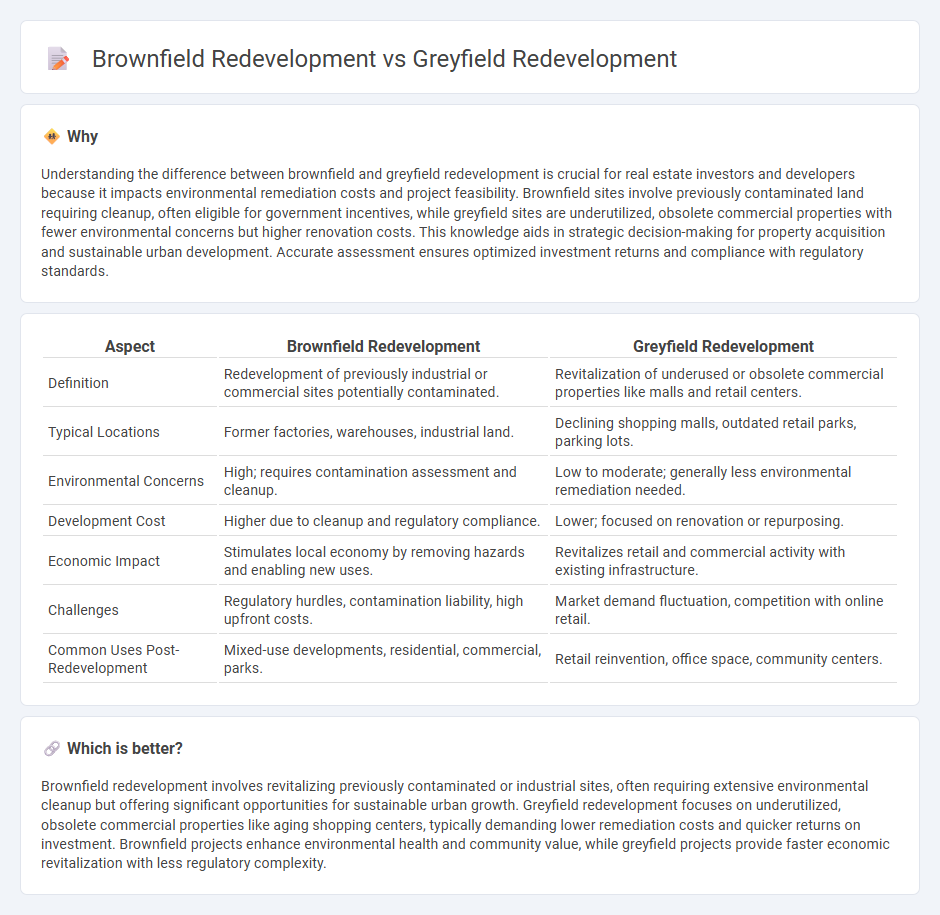
Brownfield redevelopment focuses on transforming previously industrial or contaminated sites into usable real estate, often requiring environmental cleanup to make the land safe for new construction. Greyfield redevelopment involves repurposing underutilized or obsolete commercial properties, such as aging shopping malls, to revitalize economic value and community use. Explore the distinct challenges and benefits of brownfield and greyfield projects to understand their impact on sustainable urban development.
Why it is important
Understanding the difference between brownfield and greyfield redevelopment is crucial for real estate investors and developers because it impacts environmental remediation costs and project feasibility. Brownfield sites involve previously contaminated land requiring cleanup, often eligible for government incentives, while greyfield sites are underutilized, obsolete commercial properties with fewer environmental concerns but higher renovation costs. This knowledge aids in strategic decision-making for property acquisition and sustainable urban development. Accurate assessment ensures optimized investment returns and compliance with regulatory standards.
Comparison Table
| Aspect | Brownfield Redevelopment | Greyfield Redevelopment |
|---|---|---|
| Definition | Redevelopment of previously industrial or commercial sites potentially contaminated. | Revitalization of underused or obsolete commercial properties like malls and retail centers. |
| Typical Locations | Former factories, warehouses, industrial land. | Declining shopping malls, outdated retail parks, parking lots. |
| Environmental Concerns | High; requires contamination assessment and cleanup. | Low to moderate; generally less environmental remediation needed. |
| Development Cost | Higher due to cleanup and regulatory compliance. | Lower; focused on renovation or repurposing. |
| Economic Impact | Stimulates local economy by removing hazards and enabling new uses. | Revitalizes retail and commercial activity with existing infrastructure. |
| Challenges | Regulatory hurdles, contamination liability, high upfront costs. | Market demand fluctuation, competition with online retail. |
| Common Uses Post-Redevelopment | Mixed-use developments, residential, commercial, parks. | Retail reinvention, office space, community centers. |
Which is better?
Brownfield redevelopment involves revitalizing previously contaminated or industrial sites, often requiring extensive environmental cleanup but offering significant opportunities for sustainable urban growth. Greyfield redevelopment focuses on underutilized, obsolete commercial properties like aging shopping centers, typically demanding lower remediation costs and quicker returns on investment. Brownfield projects enhance environmental health and community value, while greyfield projects provide faster economic revitalization with less regulatory complexity.
Connection
Brownfield redevelopment and greyfield redevelopment are connected through their shared focus on revitalizing underutilized or contaminated urban properties to stimulate economic growth and improve community infrastructure. Both approaches aim to repurpose existing sites, with brownfields typically involving former industrial or commercial land affected by environmental pollution, while greyfields refer to vacant or underperforming retail and commercial centers. Strategic redevelopment of these sites supports sustainable urban planning by reducing urban sprawl and enhancing land value within metropolitan regions.
Key Terms
Existing Infrastructure
Greyfield redevelopment involves revitalizing underutilized or obsolete commercial properties, often shopping malls, leveraging existing parking lots and utilities to reduce costs. Brownfield redevelopment targets lands previously used for industrial or commercial purposes with potential environmental contamination, requiring remediation before utilizing existing infrastructure. Explore further to understand cost implications and environmental benefits of both redevelopment types.
Environmental Contamination
Greyfield redevelopment typically involves revitalizing economically obsolete retail or commercial properties with minimal environmental contamination, allowing for faster cleanup and reuse. In contrast, brownfield redevelopment targets previously industrial or commercial sites with significant environmental contaminants like heavy metals or petroleum hydrocarbons requiring extensive remediation processes. Explore detailed strategies and case studies in brownfield and greyfield redevelopment for deeper insights into managing environmental contamination challenges.
Land Use Conversion
Greyfield redevelopment transforms underutilized or economically obsolete retail or commercial properties, often in suburban settings, into vibrant mixed-use spaces that maximize land use efficiency. Brownfield redevelopment focuses on rehabilitating contaminated or industrial sites, addressing environmental hazards to restore land value and enable safe, sustainable new uses. Discover more about the strategic approaches and benefits of each land use conversion method.
Source and External Links
Greyfield Redevelopment - eTools - Greyfield redevelopment involves revitalizing underperforming or vacant commercial properties (like malls or big-box stores) through flexible zoning, financial incentives, and multimodal connections to create vibrant mixed-use or industrial spaces, supporting compact urban growth and open space preservation.
Greyfield redevelopment : a growth management opportunity - Greyfields are declining or vacant shopping centers that can be transformed into mixed-use communities, helping cities focus growth inward and achieve sustainable smart growth goals instead of expanding into greenfield areas.
Revitalizing Greyfields: A Sustainable Future - Number Analytics - Greyfield redevelopment offers a sustainable architectural approach to breathe new life into urban landscapes by repurposing obsolete commercial sites into environmentally responsible, revitalized spaces.
 dowidth.com
dowidth.com